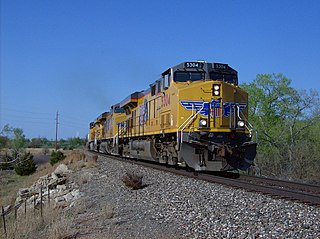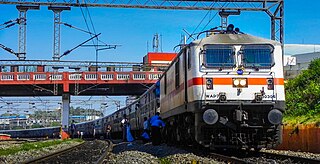| Built | Joint Venture |
|---|---|
| Operated | 2019 |
| Location | Marhowra, Saran District, Bihar, India |
| Industry | Railway |
| Products | Diesel Locomotive |
| Area | 226 acres |
| Owner(s) | General Electric & Ministry of Railways |
The Diesel Locomotive Factory, Marhowra is a joint venture of GE Global Sourcing India Pvt. Limited of the US with Indian Railways for the production of 1000 high-power freight locomotives over a period of 10 years designed to run on Indian railway tracks. [1] The factory is currently under-construction. [2] This factory will start manufacturing the locomotives from the third quarter of 2018. [3]
The first 40 locomotives will be imported, the rest will be manufactured in Marhowra. [4] The company is also setting-up two maintenance depots at Gandhidham in Gujarat and Roza in Uttar Pradesh. [5]
During Sep 2013, the Ministry of Railways had received bids from six global firms: Siemens, Alstom, Bombardier, General Electric, CSR Corp and CNR Corp. [6] However, Indian Railways rejected the bid of both Chinese firms (CSR and CNR) for the two giant manufacturing projects in Bihar. [7]
In January 2014, the Union Cabinet gave its approval for setting up Electric Locomotive Factory in Madhepura and Diesel Locomotive Factory (DLF) in Marhowra at an approximate cost of ₹1,293.57 crore (US$190 million) and ₹2,052.58 crore (US$300 million) respectively. [8]
On November 9, 2015, the Ministry of Railways awarded the contracts for Madhepura project and Marhaura project to Alstom and General Electric respectively in a collective amount of US $6 billion. This multi crore rupees deal was seen as the country's first FDI in the railway sector. [1]
General Electric’s first diesel locomotive arrived in India on October 11, 2017 from the US. [9] [5]
The factory is located at Marhaura (also spelt as Marhowrah), a town and an administrative sub-divisional area in Saran district in the Indian state of Bihar. Marhowrah is 81 km north of state capital Patna. Chhapra is the nearest railway station approximately 18 km from this factory. [10]
As a joint venture company, both Indian Railways and General Electric are set to invest collectively a huge amount of US $2.5 billion for DLF. Indian Railways will hold 26% equity in JV company subject to a maximum of ₹100 crore (US$14 million). [1] The estimated cost of 1000 locomotives will be around ₹14,656 crore (US$2.1 billion). General Electric will maintain the locomotives for 13 years, after which the Indian Railways will take over maintenance. [10]
There will be two types of diesel electric locos – 700 WDG 4G locos of 4,500 horsepower (HP) and 300 WDG 6 locos of 6,000 HP. [11] [3] [5]

Rail transport is an important mode of transport in India.

Indian Railways (IR) is India's national railway system operated by the Ministry of Railways. It manages the fourth largest railway network in the world by size, with a route length of 67,368-kilometre (41,861 mi) and total track length of 121,407-kilometre (75,439 mi) as of March 2017. About 60% of the routes are electrified with 25 kV 50 Hz AC electric traction while 33% of them are double or multi-tracked. The government has committed to electrify its entire rail network by 2023, and become a "net-zero railway" by 2030.
The Diesel Locomotive Works (DLW) in Varanasi, India, is a production unit of Indian Railways, that manufactures diesel-electric locomotives and its spare parts. It is the largest diesel-electric locomotive manufacturer in India. It is located on DLW to BHU road of the metropolitan city of Varanasi.

The Evolution Series is a line of diesel locomotives built by GE Transportation Systems, initially designed to meet the U.S. EPA's Tier 2 locomotive emissions standards that took effect in 2005. The first pre-production units were built in 2004. Evolution Series locomotives are equipped with either AC or DC traction motors, depending on the customer's preference. All are powered by the GE GEVO engine.

Prima is a family of railway diesel and electric locomotives built by Alstom. During the late 1990s, manufacture of the type had commenced; by 2008, Alstom had reportedly sold 1,750 Prima locomotives. In 2009, the second generation Prima II was launched. During 2013, the Prima H3 diesel/battery hybrid locomotive was launched.

The Indian Railways primarily operates electric and diesel locomotives. Steam locomotives are operated on a few World Heritage sites and also run occasionally as heritage trains. A locomotive is also known as a loco or engine. The country's first steam locomotive ran on the Red Hill Railway from Red Hills to the Chintadripet bridge in Madras in 1837.

Chittaranjan Locomotive Works is a Government electric locomotive manufacturer based in India. It is located at Chittaranjan near Asansol with an ancillary unit in Dankuni. It is the largest locomotive production unit in the world with a record of 402 locomotives produced in a year. Almost all electric locomotives running on Indian Railways are manufactured at CLW.
Rail Wheel Factory, Yelehanka (RWF) is a manufacturing unit of Indian Railways, producing wheels, axles and wheel sets of railroad wagons, coaches and locomotives for the use of Indian Railways and overseas customers is situated at Yelahanka, Bangalore in the Indian state of Karnataka.

The Alstom PL42AC is a class of four axle Bo-Bo diesel-electric locomotive designed by Alstom in association with GM-EMD between 2003 and 2006 for New Jersey Transit, USA.

The WAG-9 is a type of electric locomotive used by the Indian Railway It was the most powerful freight locomotive of its fleet until the formal induction of the WAG-12. It is similar to the WAP-7 class locomotive but features a different gear ratio, which makes it suitable for heavy freight operations. In November 1998, the Chittaranjan Locomotive Works (CLW) started producing these with indigenous components. The first of which, named Navyug, was produced on 14 November 1998. Like the WAP-5 units, the WAG-9 has GTO thyristor converters and three-phase asynchronous motors.

The EMD GT46MAC is a freight-hauling diesel-electric locomotive with AC electric transmission built by General Motors Electro-Motive Diesel in 1997–1998 for Indian Railways, where they are classed as WDG 4. Thirteen were built by EMD as order #958647, and a further eight were exported in kit form and were assembled in India. The class entered service in 1999.

The EMD GT46PAC or WDP-4 is a passenger-hauling diesel-electric locomotive with AC electric transmission designed by General Motors Electro-Motive Division and built by both GM-EMD and under license by Diesel Locomotive Works (DLW) of Varanasi, India for Indian Railways as their classes WDP-4, WDP-4B and WDP-4D. The GT46PAC is a passenger version of the previous Indian Railways EMD GT46MAC freight locomotive. The locomotive has a 16-cylinder 710G3B diesel engine with a maximum speed of 904 RPM.

The ALCO DL560C is a passenger/freight-hauling diesel-electric locomotive with AC electric transmission designed by the American Locomotive Company and produced under license by Diesel Locomotive Works (DLW) of Varanasi, India for Indian Railways as their classes WDM-2, WDM-3A/2C, WDM-3D and WDG-3A for operation in India. The locomotive is fitted with a 16-cylinder ALCO 251 B,C diesel engine. In the early 1960s Indian Railways needed a reliable diesel workhorse to gradually replace its steam locomotive fleet. Equal numbers of ALCO's DL560C and EMD's SD24 were chosen for trials. More locomotives of each of these were purchased for more trials. Indian Railways was keen on producing these locomotives in the country rather than depending on imports. EMD did not agree for a Transfer-of-Technology, while ALCO did. Thus ALCO DL560C was chosen for the job due to its easy maintenance, reliability and simple operation. And from then on vast numbers of this loco in different configurations have been produced and they still continue to dominate the diesel route of Indian Railways.

The AD43C is a type of mainline 6 axle Co'Co' diesel locomotive designed by Alstom and used by the Islamic Republic of Iran Railways (RAI). It was in production from 2000. Delivery started in 2002.

The WAG-12 is a three phase, twin-section electric freight locomotive consisting of two identical sections, each of which rests on twin-axled bogies. The locomotive is being jointly developed by Alstom and Indian Railways, and is the first Indian Railways locomotive that has a power output greater than 10,000 horsepower. With a power output of 12,000 hp, it is twice as powerful as its immediate predecessor, WAG-9, and is one of the most powerful freight locomotives in the world. The locomotive is being developed for deployment on the Eastern Dedicated Freight Corridor, where it will be used to haul freight trains weighing more than 6,000 tonnes at speeds of 100 km/h (62 mph) to 120 km/h (75 mph), essentially doubling the average speed of freight trains in the sector.
The Indian government is undertaking several initiatives as to upgrading its aged railway infrastructure and enhance its quality of service. The Railway Ministry has announced plans to invest ₹905,000 crore (US$131 billion) to upgrade the railways by 2020. IR's Research Design and Standards Organisation (RDSO) undertakes all research, designs and standardisation work for modernisation.

The Electric Locomotive Factory, Madhepura is a joint venture of Alstom SA of France with Indian Railways for the production of 800 high-power locomotives over a period of 11 years designed to run on Indian tracks at 120 km per hour. The manufacturing has started on 11 October 2017.

Gonda Junction Railway Station is a very big railway station in Devipatan division, Gonda district, Uttar Pradesh. Its code is GD. It serves Gonda city. The station consists of five platforms. It has good connectivity via roadways. It has various facilities like Escalator, Elevator, Free Wi-Fi, ATVM, Dormitory, Food Stall, Parking.
The WDG-4G is a class of 4,500 HP Diesel-electric freight locomotive developed by GE Transportation based on its existing Evolution Series of locomotives for Indian Railways. The locomotives will be manufactured in a newly constructed factory(Diesel Locomotive Factory, Marhowra) in Bihar. They will be used exclusively for freight hauling and will replace the existing fleet of old Alco locomotives. They will also feature the most fuel efficient diesel engine(GEVO) used till now by Indian Railways. For driver's comfort,cabs will have air conditioning and toilets.

The class WDG-3A is an diesel-electric locomotive used by Indian Railways.It is the dedicated freight version of the hugely successful WDM-2 and share the same engine and horsepower rating with WDM-3A. It was mostly built by DLW,varanasi with a few units being produced by Diesel Loco Modernisation Works and parel workshop.